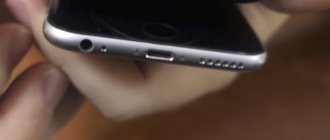A speaker speaker is a speaker that outputs sound to the top of the device. This speaker is on when you receive phone calls. Be sure to check ] to see if the problem is in the device software. If the problem is with the actual hardware of the device, follow this guide to replace the speaker speaker. Be warned - replacing this part includes damaging your phone's waterproof seal. If you want your phone to maintain its waterproof properties, you need to replace the seal.
Navigation
- Step 1
- Step 2
- Step 3
- Step 4
- Step 5
- Step 6
- Step 7
- Step 8
- Step 9
- Step 10
- Step 11
- Step 12
- Step 13
Lost contact at the speaker connection point
This is possible as a result of the phone hitting a hard surface or being dirty. To check this version, you need to disassemble the phone and inspect the contact. If the cause of the malfunction is moisture or dirt, clean the contact.
- If the presser contacts flat surfaces, treat them with a regular eraser.
- If the speaker is mounted on a cable, put a little alcohol on a stiff brush or toothbrush with medium-hard bristles and clean the connectors with it.
If this does not help, then it is possible that the speaker itself is to blame. Note that in this case, sometimes the speaker works, but the phone wheezes when talking. Possible causes of speaker malfunction:
- ingress of dirt or moisture;
- manufacturing defects;
- damage caused by prolonged use of the phone.
In the last two cases, the problem is solved by contacting a repair center with a request to replace the speaker.
We repair a mobile phone speaker ourselves
The fact that the speaker for a mobile phone requires urgent replacement is evidenced by extraneous noise when using the phone or a complete absence of sound. From the practice of specialists: repairing a damaged speaker is a painstaking and thankless task, since the repaired part is unlikely to last long. To make your phone work like new and serve you faithfully for a long time and productively, it is enough to replace the speaker.
By installing a new speaker for your mobile phone, you can not only restore the sound functions of the gadget, but also significantly improve the sound. You can carry out the replacement either at home or in a service center, where the work will be done much faster and with better quality.
If you still decide to install a speaker for your mobile phone , then we suggest using a small algorithm of actions for the most convenient work. Replacing a speaker is not as complicated an operation as it seems at first glance. The main thing is to have the necessary tools at hand, some knowledge, a desire to work and perseverance.
And the most important thing is self-confidence. The most necessary tool, in this case, is a soldering iron with a thin tip. Even when removing a faulty part, in no case should it be torn off or pulled out; you must carefully desolder the contacts with a soldering iron and pull out the old speaker. In any case, the repair must begin by disassembling or unscrewing the phone, that is, removing the back cover.
In each phone, the mobile speaker may be located in different places, but it is not difficult to find it. Having freed the phone from the old one, we did it as indicated above, and having two free contacts at our disposal, we can install a new spare part. You should work with a soldering iron very carefully, since due to the small size of the speaker, the contacts are located quite close to each other, and if you are not careful, you can connect them, thereby provoking their short circuit and combustion.
If you decide to install a speaker from another phone model to increase the sound capabilities of your gadget, keep in mind that due to non-standard sizes, it may extend beyond the boundaries of the gadget. The new spare part on the board should be installed strictly in the place where the old one was installed. When installing a speaker removed from another mobile device, keep in mind that the sound quality may vary on different devices.
If you are going to install a mobile speaker on a slider, then you must first disconnect the cable by pulling it out of the case or disconnecting it from the screen under the front cover. The second option allows you not to completely disassemble the phone, which allows you to complete the installation of a new component much faster.
If you still doubt your abilities, you should not take risks and disassemble the device yourself. Use the services of the service center.
Level four. Complete replacement of the standard system
There are situations when you are not satisfied not only with the sound of the standard system, but also with the functionality of the head unit itself. In this case, thoughts about replacing it become especially annoying. But this cannot always be done with small forces.
Initially, this Honda was equipped with a standard head unit integrated into the dashboard. Using a non-standard panel, it was possible to install a new head unit of standard DIN sizes
First of all, take a close look at what the standard head unit is. If it has its own display, and all audio system controls are not connected to other car systems (climate control, on-board computer, etc.), then it can most likely be safely removed, while all other systems will remain unaffected.
Don't let the original shape and size of the standard GI confuse you. Firstly, there are now many alternative head units that are produced for specific car brands and fit into the panel using the pin-to-pin principle - the seats and connectors are completely the same. Or you can use an adapter frame to install a standard 1DIN or 2DIN size device and an adapter from a standard connector to a standard ISO. They are produced by many manufacturers, so choosing the right set is usually not difficult. As a last resort, no one has canceled the custom solution either.
If the standard head unit has many standard functions, then replacing it is a very difficult task; there are not simple solutions for every car. Pictured is an Alpine kit designed specifically for Mercedes
But if the standard “head” is combined with other car systems, then it’s more complicated. It is far from a fact that there is an alternative head unit for your car. In this case, the approach will be individual, and most likely costly.
This McIntosh became the head of the new audio system, and a mounting frame was made especially for it. All that remains of the standard system is the head unit, which now serves as the second most important source
But there is another option. It looks quite extravagant, but sometimes the only way to organize a truly high-quality audio source in a car is to leave the standard head unit unchanged and install a second one. In this case, it becomes the main one in the system, and the audio system is built from it. The standard one is shifted from the role of the main one in the system and becomes additional - its outputs are connected to the AUX inputs of the new head unit.
Source
Acoustic speaker repair
When repairing acoustic speakers with your own hands
The most difficult process will be rewinding the voice coil. This is labor-intensive and delicate work. After the diffuser along with the coil is removed from the housing, you need to carefully wind up the burnt or torn wire. You don’t have to count the turns so as not to get lost. It is enough to measure the length of the wound wire and measure its diameter with a micrometer to select a similar piece. To wind the coil, you need to use a mandrel of the appropriate diameter onto which the voice coil is placed. This way you can avoid creasing the paper frame. The voice coil is wound strictly turn to turn. For fixation, it is best to use BF-2 glue.
Once the coil has completely dried, the assembly can be assembled. With a little experience, the answer to the question of whether the speakers can be restored will be positive.
How to increase the volume on your phone when talking
Many phones that have a keypad have weak speakers. When communicating with other people on the phone, their voice may be barely audible. You have to listen to literally every word to understand what they are saying. Try using your phone's joystick during a conversation. These are several combined buttons with which the user can navigate through menu items and move the phone’s focus to the left or right when selecting parameters.
Depending on the purpose of the buttons, the volume will be added if you press the joystick to the right or up. You can similarly reduce the volume level.
Car Speaker Repair
Car sound systems consist of two or three-way coaxial-type systems and a subwoofer. The coaxial device has an oval or round shape. Its design feature is the installation of a high-frequency head or “tweeter” on a special plate above the broadband acoustics diffuser. The system takes up little space, and the high-frequency head does not interfere with the propagation of sound waves. Car acoustics are subject to many negative influences. The presence of dust and constant vibration are the cause of failure of automotive audio systems.
Some models of coaxial car speakers consist of three speakers. Two of which - high-frequency and mid-frequency - are installed above the woofer. Most often, a malfunction occurs in the broadband head. Restore the speakers in the car
Can. This will require a simple tool and some skills. When repairing oval speakers with your own hands, you first need to remove the high-frequency unit.
To do this, you need to unscrew the central screw located on the rear flange of the speaker.
The screw head is usually sealed.
You need to remove the label, then the screw head will be accessible.
After the module is removed, you need to carefully unsolder the wires that go to it. Now you can work on the broadband head. The rubber suspension of the diffuser is pressed against a plastic pad. It needs to be pryed off with a flat screwdriver or a knife blade and removed from the diffuser holder. Then separate the rubber diffuser suspension. It is glued with elastic rubber-type glue, so you can pick up the edge with a screwdriver and then carefully peel it off with your hands. When the edge of the diffuser is completely separated from the metal base, the centering washer is removed. First, the voice coil wires should be unsoldered from the contact plate. Then very carefully peel off the centering washer. It is very easy to damage, so it is better to do the job with a flat and thin screwdriver.
When the speaker is completely disassembled, you can start looking for the defect. A malfunction of the acoustic system is determined by ear during operation. The sound in the speaker becomes distorted, wheezing and crackling appear, especially at high volume levels. Sometimes high frequencies disappear completely, and the sound becomes dull and unintelligible. Mostly do-it -yourself auto speaker repair
comes down to cleaning the magnetic gap of the broadband head from foreign inclusions. Most often, dirt or dust gets into the gap of the permanent magnet.
You can use a vacuum cleaner to remove debris. It is more difficult to remove metal particles from the gap. The speaker magnet is strong and a vacuum cleaner will not help here. When removing magnetic particles, regular tape will help. Small strips of it are inserted into the gap using a thin plate of textolite or other non-magnetic material. Then they are removed along with the adhered particles.
This operation should be repeated several times. You can see the quality of work using a powerful lamp and magnifying glass. The assembly is assembled in the reverse order. It is better not to remove the old glue, as this will allow the diffuser to be installed accurately. All gluing can be done with regular Moment glue. After installing the diffuser, you need to check by hand how well the voice coil moves in the magnet gap. There should be no mechanical interference. The coil should move without effort or rustling. Car speaker restoration and repair
does not require special knowledge, so
anyone can repair speakers with their own hands
Level one. Noise insulation
Yes, yes, this is the very first point for any upgrade of a standard audio system. If you want to listen to music, first of all get rid of unnecessary sounds. By the way, we are talking not so much about outside noise as about body noise. Look at the home speaker. Durable body, devoid of overtones. Sound emits only what should emit sound, and what should not be held monolithically. Now take a look at where and how any car speaker is installed and what the housing is for it. Most often it is mounted on some kind of metal panel, and in the worst case, even on plastic upholstery. And the body of such a “column” is a door or some kind of body niche. Tough, and that's all. By the way, in the literal sense of the word.
The easiest way to improve the acoustic operating conditions of speakers and get rid of unnecessary resonances and other metallic sounds is to use vibration-damping materials. They are usually made from bitumen or rubber, often with some additives. Their main feature is high internal viscosity. Basically, these are just sheet materials that are cut right on site and carefully rolled onto the metal. But sometimes such materials come in the form of mastics.
Treatment with vibration-damping materials eliminates metallic sounds and improves the operating conditions of installed speakers
Vibration-damping materials are heavier and more rigid, more effective, but they are also harder to work with, so not all craftsmen like them. Thinner and lighter ones are easier to work with, but their effect is not so high. The optimum is usually somewhere in the middle.
Various kinds of lightweight foam and fibrous materials can be considered only optionally; they work somewhat differently and do not have much effect on the absorption of metal vibrations.










